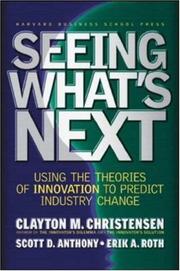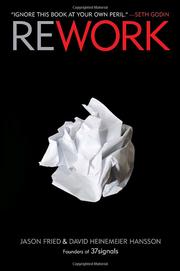Seeing What's Next: Using the Theories of Innovation to Predict Industry Change - by Clayton M. Christensen, Scott D. Anthony, Erik A. Roth - ISBN 1591391857 - Harvard Business Review 2004
Motivation
Clayton Christensen is probably the most famous author on innovation thus knowing his work is required for communication with others on the topic.
Pre-reading model
Draw a schema (using PmGraphViz or another solution) of the situation of the area in the studied domain before having read the book.
Reading
- Introduction
- describing theory building
- linking with previous books by Clayton Christensen
- justifying the choice of the telco industry
Part I: How to Use Theory to Analyze
- 1 The Signals of Change
- (p3)
- Key points
- What jobs are customers in the industry trying to gt done? Are customers not served, undershot, or overshot by current offerings? Along which dimension do firms compete for customers?
- What improvements garnered premium prices in the past?
- Do integrated or specialized business models currently prevail? Are interfaces specifiable, verifiable, and predictable? If so, where is modularity occurring?
- Where are new business models emerging? Is there growth in fringe markets?
- What roles does the government or its regulatory bodies play in enhancing or inhibiting innovation?
- 2 Competitive Battles
- (p29)
- Key points
- What are industry players' business models? What are their motivations? What are their skills?
- How do industry players compare to one another? How do they compare to the needs of the market? Where are there symmetries? Where are there asymmetries?
- Do the asymmetries tilt in favor of the attacker or the incumbent?
- Does the innovation naturally fit its target market? Is there evidence of cramming?
- Are there signs that a company is ceding a low-end market and trying to move up? Is there an "up" to move to? For how long?
- 3 Strategic Choices
- (p53)
- Key points
- Is a company in a situation in which the right strategy needs to emerge? Is there firm giving itself the freedom to encourage emergent forces? Have managers wrestled with problems they are likely to face again? Have they shown the capacity to learn?
- Are investor values aligned with company needs? if they do, what are the degrees of overlap? Do they make it impossible to create a business model that has asymmetries?
- Is this an appropriate situation for a spinout? Is the company giving the spinout the freedom to do what is necessary?
- 4 How Non-market Factors Affect Innovation
- (p73)
- using US telco market to show how regulation and have positive and negative impact, the role of motivation of the players
Part II: Illustrations of the Theory-Based Analysis
- 5 Disruptive Diploma
- (p99)
- Key points
- Non-consumption exists, even in contexts in which everyone seems to be consuming.
- Making is easier for non-consumers to do things that matter to them is the ticket to growth.
- Companies can adopt the same innovation in different ways.
- Companies can start at the fringes and then move to the core to avoid being snared in government regulation.
- All organization - even nonprofit ones- have skills and motivation that drive what they can and cannot do.
- 6 Disruption Spreads its Wings
- (p129)
- Key points
- Skills and motivation define companies' strengths and weaknesses, creating opportunities for new sorts of companies and determining companies' likely response to disruptive growth.
- Companies can create growth without incumbent response by leveraging asymmetric motivation.
- An industry's context can affect how companies react to disruptive threats.
- Companies with disruptive potential can choose co-optable business models by situating themselves in overlapping value networks.
- A company's choice of initial market can increase its disruptive potential.
- 7 Whither Moore's Law?
- (p155)
- Key points
- The principle of conservation of integration helps describe how value chains need to reconfigure when the basis of competition shifts.
- Customers showing less interest in paying for performance increases and the entrance of non-integrated firms that specialize at one stage of value added indicate overshooting.
- Overshooting enables companies to change the basis of competition, take advantage of rules-based design and manufacturing, and shift production closer to the customer.
- Disruptive business models are difficult for incumbents to respond to because they take unique advantage of blind spots and skills gaps.
- see Rodney Brooks' remark on benefiting from industries "trapped" into progress loops
- note that thinking Moore's law is linking to the ability of mass market consumers to leverage computation might be wrong, before the IT "revolution" processor were improving and most people did not having computers
- today they keep on improving via supercomputers and the cloud even if the desktop/netbook are not following the same pace
- 8 Healing the 800-Pound Gorilla
- (p179)
- Key points
- Scientific progress leads to better categorization and the development of rules guiding prevention and treatment.
- Those rules open the door for less-skilled people to do what previously required deep expertise.
- Non-market forces affect the market for innovation by influencing industry players' motivation and ability.
- 9 Innovation Overseas
- (p207)
- note that most chapters so far have been focusing nearly only on the U.S. market
- 10 Breaking the Wire
- (p227)
- Key points
- The analytical approach laid out in chapters 1 through 3 can bring order to innovations in complicated industries.
- Theory can focus attention to the signs that signal an innovation's and an industry's evolution.
- Be wary of overestimating the chances that an innovation will overthrow incumbent leaders. Look at the co-optability of the innovation and the motivation of incumbents to fight the disruption rather than flee it.
- Highly interdependent networked industries provide avenues for co-option.
- Developments in the fringe always bear watching.
- Conclusion: What's Next?
- Four critical lessons (p268)
- Disruption is a process, not an event.
- Disruption is a relative phenomenon. What is disruptive to one company may be sustaining to another company.
- Different or radical technology does not equal disruptive.
- Disruptive innovations are not limited to high-tech markets. Disruption can occur in any product or service market and can even help explain competition among national economies.
- warning against potential quantitative check for the prediction as the major point being to provide an helpful tool through the theory (p272)
See also
Overall remarks and questions
- very well structured
- key points for each chapter
- some schema for the first part
- a conclusion summarizing then restating all key points
- reviews and blog posts still to explore
Synthesis
So in the end, it was about X and was based on Y.
Critics
- requires a bid-eye view of the market that is really hard to have in the present but easy to have a posteriori
- specific vocabulary
- but there is a complete glossary
- Cramming (competitive battles) = Occurs when companies try to stretch an under-performing disruptive innovation to meet the needs of demanding customers in mainstream markets. Cramming is expensive, leads to disappointed customers, and generates little new growth.
- Incumbent = An established firm within a market segment. Established firms that go to new markets are considered entrants in that market segment.
- Job to be done = A circumstance in which an individual is trying to solve a problem or accomplish a task. Companies find success when they make it easier or more convenient for customers to do jobs that they had already been trying to do. A product usually fails when managers expect their customers to prioritize something that they historically had not been trying to do.
- Overshot customers (VCE theory, disruptive innovation theory, signal of change) = A particular customer segment for which existing products or services are more than good enough. Companies can reach these customers with low-end disruptions. Modular interfaces tend to emerge once overshot customers emerge, allowing companies to follow defined rules to develop good-enough products. When companies develop new ways to reach overshot customers, it is a signal of change.
- Undershot customers (VCE theory, disruptive innovation theory, signal of change) = A particular customer segment for which existing products or services are not yet good enough.
- rather dogmatic
- recurring examples through the book, through the previous books and also through the other media covering its content
- what is the difference with
- more accurately defining the needs of the customers? very often the example given can be summed up by removing unwanted and costly features
- targeting a niche first then growing "up"?
- see DemonsInEden for the biological equivalent, other organisms that initially able to take a niche would actually find it too costly and thus leave it to organisms they could overtake
Vocabulary
(:new_vocabulary_start:)
new_word
(:new_vocabulary_end:)
Post-reading model
Draw a schema (using PmGraphViz or another solution) of the situation of the area in the studied domain after having read the book. Link it to the pre-reading model and align the two to help easy comparison.
Categories
Back to the Menu
Other read books linking to the SeeingWhatsNext page :
Back to the Menu
 Fabien Benetou's PIM
Fabien Benetou's PIM







